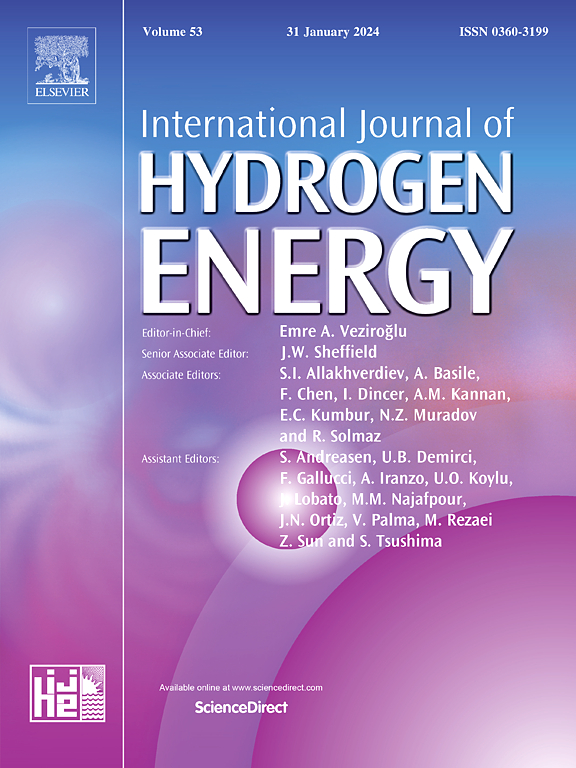High-performance Mo2Ti2C3Tx/MoS2 hybrid electrocatalyst for sustainable hydrogen production
IF 8.3
2区 工程技术
Q1 CHEMISTRY, PHYSICAL
引用次数: 0
Abstract
Hydrogen (H2) is widely regarded as a clean and sustainable energy carrier with the potential to mitigate environmental challenges associated with fossil fuel consumption. However, the scalability of electrochemical water splitting (EWS) for H2 production is constrained by the high cost and limited availability of efficient electrocatalysts such as platinum (Pt), which are critical for driving the hydrogen evolution reaction (HER). To address these challenges, there is growing interest in developing cost-effective, earth-abundant alternatives to precious metal-based electrocatalysts. In this study, we report the design and synthesis of a novel composite electrocatalyst comprising a double transition metal (DTM) MXene molybdenum titanium carbide (Mo2Ti2C3Tx) integrated with molybdenum disulfide (MoS2) for HER in alkaline media. By systematically optimizing the MoS2-to-MXene ratio, we identified the composite formulation MMS-2 as the most effective, achieving an overpotential of 298 mV at a current density of 10 mA/cm2. Additionally, MMS-2 exhibited a high electrochemical active surface area (ECSA) of 195 cm2 and demonstrated exceptional stability, maintaining a consistent performance over 24 h at 10, 20, and 30 mA/cm2 current densities. These results highlight the potential of the MMS-2 composite as a durable and effective electrocatalyst for advancing sustainable H2 production technologies.

高性能Mo2Ti2C3Tx/MoS2混合电催化剂可持续制氢
氢(H2)被广泛认为是一种清洁和可持续的能源载体,具有缓解化石燃料消耗带来的环境挑战的潜力。然而,电化学水分解(EWS)制氢的可扩展性受到诸如铂(Pt)等高效电催化剂的高成本和有限可用性的限制,铂(Pt)是驱动析氢反应(HER)的关键。为了应对这些挑战,人们越来越有兴趣开发成本效益高、储量丰富的贵金属基电催化剂替代品。在本研究中,我们设计和合成了一种新型复合电催化剂,该催化剂由双过渡金属(DTM) MXene钼碳化钛(Mo2Ti2C3Tx)和二硫化钼(MoS2)集成,用于碱性介质中的HER。通过系统优化mos2与mxene的比例,我们确定了复合配方MMS-2是最有效的,在电流密度为10 mA/cm2时实现了298 mV的过电位。此外,MMS-2表现出195 cm2的电化学活性表面积(ECSA),并表现出优异的稳定性,在10、20和30 mA/cm2电流密度下保持24小时的一致性能。这些结果突出了MMS-2复合材料作为一种持久有效的电催化剂的潜力,可以推进可持续的氢气生产技术。
本文章由计算机程序翻译,如有差异,请以英文原文为准。
求助全文
约1分钟内获得全文
求助全文
来源期刊

International Journal of Hydrogen Energy
工程技术-环境科学
CiteScore
13.50
自引率
25.00%
发文量
3502
审稿时长
60 days
期刊介绍:
The objective of the International Journal of Hydrogen Energy is to facilitate the exchange of new ideas, technological advancements, and research findings in the field of Hydrogen Energy among scientists and engineers worldwide. This journal showcases original research, both analytical and experimental, covering various aspects of Hydrogen Energy. These include production, storage, transmission, utilization, enabling technologies, environmental impact, economic considerations, and global perspectives on hydrogen and its carriers such as NH3, CH4, alcohols, etc.
The utilization aspect encompasses various methods such as thermochemical (combustion), photochemical, electrochemical (fuel cells), and nuclear conversion of hydrogen, hydrogen isotopes, and hydrogen carriers into thermal, mechanical, and electrical energies. The applications of these energies can be found in transportation (including aerospace), industrial, commercial, and residential sectors.
 求助内容:
求助内容: 应助结果提醒方式:
应助结果提醒方式:


